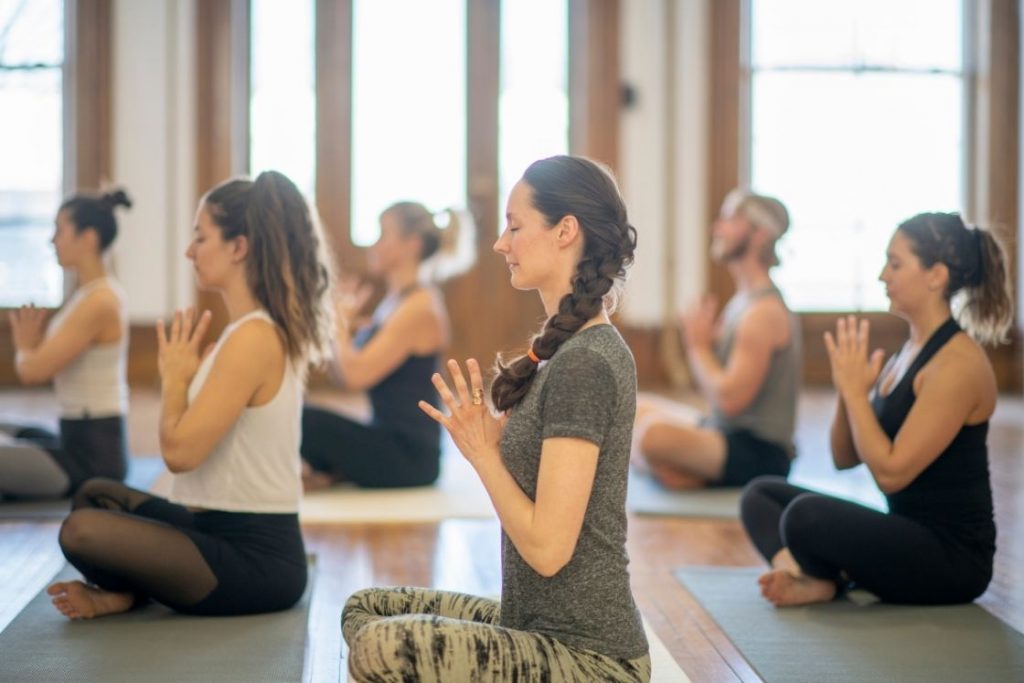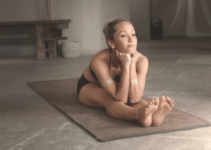- The yoga style
- Expertise of teacher
- Class time & duration
- The fees
- Class size
- Students’ reviews
- Demo class
- Abilities & shortcomings

Many congratulations if you already have decided to enrol on a yoga class! This itself is an indication that you have seen the potential benefits of yoga and are willing to give it a chance to transform your life.
Yoga transforms at all levels, leading to peaceful and productive days. The increasing awareness about yoga has led to the emergence of many yoga institutes, training centres, yoga studios, and freelance yoga instructors. So, if you have selected yoga as the skill or passion to learn, you should also select how to go about it mindfully.
Choosing a yoga class can be confusing if you look at the variety of them offline or online. You surely do not want to give up if you do not get what you looked for in the yoga course.
Well, worry no more about how you can know which is the right yoga class for you. Here we have covered some important things that you should consider checking before signing up for a yoga class.
#1 Know what yoga style is taught in class
Yoga is an ancient science that was first thoroughly discussed by Sage Patanjali in Yoga Sutras. From then to now it has received well-appreciation all over the world. Being a transformative process, yoga has been reviewed, researched, and contemplated upon in various ways.
From ancient to contemporary, there are various styles or schools of yoga that operate with the same purpose but different methodologies. When you are signing up for a yoga class, you should know in advance which yoga style is actually taught in the class you’re looking for. There are many styles of yoga today taught in different yoga studios across the globe.
These are some of the popular yoga styles you will come across in your search;
- Ashtanga Yoga – It is a classical Indian yoga style based on eight limbs of yoga. Ashtanga yoga classes are intense in nature, starts with five rounds of Sun Salutation A and Sun Salutation B. The yoga class is self-led, it means you need to have memorized the sequence, and as you go from pose to pose, the instructor assists you. Between each posture a dynamic Vinyasa flow is added, so the body is kept warm.
- Hatha Yoga – is a yoga school that emphasizes physical exercises to regulate the body and mind and help remove the distractions.
- Vinyasa Yoga – It is a modern yoga style that focuses on smooth transitions between the yoga poses synchronized with the breath. In this class, you move from one pose to another with each inhale and exhale so you won’t be holding postures for a long time. This style is useful for athletic people and those whose first priority is to get in shape.
- Power Yoga – It is another modern yoga style that emphasizes faster physical movements to regulate the body and mind. In this style, more focus is given to fat-burning. So, if you are working on your weight-loss goals, power yoga class is right for you.
- Restorative Yoga – This yoga style uses props to modify the poses to soothing exercise which helps patients who are recovering from the injury or used as a therapy for stressed patients. Hence, if your preference is therapeutic and recovery-oriented, go for the restorative yoga class.
- Yin Yoga – It’s a slow-paced yoga style that is inspired from traditional Chinese values. In yin yoga class, mostly there are long-held, passive floor poses that mainly work the lower part of the body. It’s best for beginners, who have stiff body, to begin with yin yoga class.
Along with these, there are other yoga styles as well which you can research and then check which one is best for you. Some other yoga styles you may hear of are Iyengar yoga, kundalini yoga, Bikram yoga, and Acro yoga.
#2 The Qualifications and Experience of the Instructor
When you have narrowed your research to the yoga style you wish to pursue, the next important aspect you should look for is how many institutes or teachers are instructing that yoga style.
Each of the yoga styles has its qualifications and certification criteria for yoga teachers to teach yoga to different level aspirants (beginners, intermediate and advanced). One such popular certification is Registered Yoga Teacher (RYT) provided by Yoga Alliance USA. Know about the certifications and accolades of the teacher and if he or she is eligible to guide you as you look for.
Enquire about the history of the yoga studio and the experience of the teacher teaching there. This can provide you detailed information about the expertise they possess. Also, find out if they are still undergoing any training for improving at what they do.
A yoga class is a lively place from which you come back with a fresh mind and rejuvenated soul. If the teacher is welcoming, friendly, cheerful, and an accurate guide, you will cherish the sessions more. For this, do not forget to learn about the nature and qualifications of a yoga teacher.
#3 Check the Duration and Time of the Class
The best time to practice yoga is in the morning. Some people prefer practising it in the evening. We all have different preferences on when we can be truly physically and mentally available for a yoga session. Most of the yoga institutes or teachers conduct their classes both in the mornings and evenings.
If you are signing up as a beginner, the basic course generally lasts for a month or two. That is the minimum duration of the training as a yoga beginner. You can check the duration of the class and if it suits your schedule.
Before signing up for a class, check if the yoga studio or gym you are looking for is offering classes according to your suitable time. Normally, a yoga session lasts for an hour inclusive of physical and breathing exercises plus relaxation. So you must have two to three hours of free time (including preparation, practice and after class) in order to attend a yoga class without any hustle.
Make sure you have at least one hour free before the class to set up your preparation for the yoga class. Moreover, you don’t want to spoil the calmness of mind that comes with yoga just because you have to go to work as soon as class ends. Therefore, after the class ends, keep half an hour as free hours to let the body and mind absorb yoga’s peace completely.
#4 Compare the Fees
When you are starting to learn a new skill and especially yoga, you should compare the fees of the class with its reputation. That means, if the class has well-trained and excellent teachers, the fees can be a little overwhelming.
If you are looking for a beginner’s yoga class, it ranges from $10 to $30 per class depending on the expertise of the teachers and the location of the studio. However, if you need a private class, the fees may go as high as $100 per class. Usually, these classes are 75 to 90 minutes long.
In India, the yoga classes fees are generally 200 to 500 rupees per class. Again, this figure can vary according to the expertise of a yoga teacher and your specific requirements. However, when going regularly to a yoga class (on a monthly or weekly basis) this cost can be reduced. You may ask a teacher for some relaxation in fee when going on a regular basis.
Excellent classes can also be there which offer training with a moderate fee and a great learning environment. Choose the one which is suitable for your financial situation as well as the expertise of the instructors.
#5 Consider the Class Size
Bigger or more famous institutes tend to conduct yoga classes in huge numbers. Whereas, some instructors prefer to keep their classes small. Before joining a yoga class, you must enquire about the size of the class as (being a beginner) you may feel uncomfortable in large group classes.
However, it’s not always the case that large group yoga classes are always not okay for everyone. Bikram yoga poses are generally practised in large group classes where more than 100 students happen at one time. These classes are absolutely not suitable for a beginner.
Ideally, a yoga class should not have more than 10 students at one time. It can vary depending on the size of the studio and the teacher’s convenience. But 10 students are generally easy to attend carefully. If the studio appoints one instructor and an assistant instructor, the class size can be more.
Smaller classes mean better personal attention and ultimately more sophisticated practice. There is more chance for conversation and learning, leading to more growth. You can select which class to sign up considering how many students it is training in a single batch.
#6 Go through the Students’ Reviews
Checking reviews of a yoga class you are about to join is the easiest way to have a sneak peek. Today most yoga institution have their social and business profile on different public platforms and forums where anyone can check reviews given by genuine users like you. Here you can check the ratings of the class and reviews shared by the students who got trained there. Some popular platform to check public reviews of a yoga class is Google Business Profile, JustDial, Meta, and Yelp.
This information can be available on the yoga institute website as well. You can also address your concerns to them or ask the referrals. Choose a yoga class that has good reviews, appreciates students’ efforts, and is willing to guide you through challenging yoga practices.
#7 Take a Demo Class
You can ask for demo classes with the teachers you wish to train with. A demo class can help you understand if you vibe with the instructor and if he/she is the right one to help you grow.
In demo class, check if the teacher is teaching what was advertised on the schedule or promised to you while enquiring. A basic demo class should be about building foundations and alignment in each pose. If your yoga teacher can’t tell the difference between a beginner and an advanced yoga class then they are not respecting their students.
By taking a demo class you can get an idea of the class atmosphere and whether you can be an active part of it.
#8 Understand Your Abilities and Shortcomings
It is also necessary to assess your own self before signing up for a yoga class. Having a good knowledge about your own body and its tendencies can help in progressing in yoga later on.
Some people learn the sequences fast, whereas some need time. Understand what type you are before signing up for a yoga session. Prepare yourself to be consistent in practice. Do not give up if you face obstacles on the way.
If you have had any recent surgery or injury, inform your instructor about it before starting the class. It will help the teacher in planning a suitable yoga sequence for you.
Final Thoughts
Learning yoga is a challenging yet satisfying journey. It starts with a few pains as you get up after the first session but progresses to a strong and coordinated body and mind.
The beginning of any process is important. Similarly, starting off your yogic journey with an excellent yoga session is important too. After all, it is the initial training that will determine your future progress.
With the ways described above, research thoroughly before joining a yoga class. Let your first experience of yoga be decisive for your prospective yogic growth! All the best!




